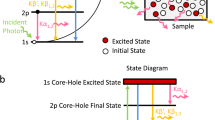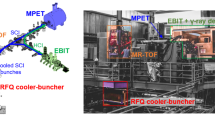Abstract
In recent TRIUMF experiments, a μ- beam is stopped in a solid hydrogen film with a small fraction of T2. The Ramsauer-Townsend (RT) mechanism allows μt to escape into vacuum with a few eV of energy. To study the emission process, an imaging system was used to determine the position of muon decays. Experimental histograms are in good agreement with a Monte Carlo simulation.
Similar content being viewed by others
References
See G.M. Marshall et al., this issue and references contained therein.
P.E. Knowles et al., Nucl. Instrum. Methods A 368 (1996) 604.
B.M. Forster et al., Hyp. Interact. 65 (1990) 1007; G.M. Marshall et al., in: Proc. of the Internat. Symp. on Muon Catalyzed Fusion CF-89, Oxford (1989) ed. J.D. Davies (Rutherford Appleton Laboratory Report RAL-90-022).
Author information
Authors and Affiliations
Rights and permissions
About this article
Cite this article
Huber, T., Adamczak, A., Bailey, J. et al. Time-of-flight studies of emission of μt from frozen hydrogen films. Hyperfine Interactions 118, 159–161 (1999). https://doi.org/10.1023/A:1012605107552
Issue Date:
DOI: https://doi.org/10.1023/A:1012605107552




